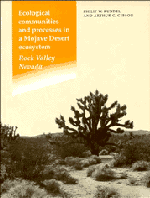Book contents
- Frontmatter
- Contents
- Preface
- Historical prologue on Rock Valley studies
- 1 Introduction to the Mojave Desert
- 2 Physical geography of Rock Valley
- 3 Adaptations of Mojave Desert plants
- 4 Desert perennials of southern Nevada
- 5 Mojave Desert annuals
- 6 Adaptations of Mojave Desert animals
- 7 Mammals
- 8 Reptiles
- 9 Birds
- 10 Arthropods
- 11 Soil organisms and seed reserves
- 12 Nitrogen cycling
- 13 Human impacts on Mojave Desert ecosystems
- References
- Species index
- Main index
12 - Nitrogen cycling
Published online by Cambridge University Press: 19 October 2009
- Frontmatter
- Contents
- Preface
- Historical prologue on Rock Valley studies
- 1 Introduction to the Mojave Desert
- 2 Physical geography of Rock Valley
- 3 Adaptations of Mojave Desert plants
- 4 Desert perennials of southern Nevada
- 5 Mojave Desert annuals
- 6 Adaptations of Mojave Desert animals
- 7 Mammals
- 8 Reptiles
- 9 Birds
- 10 Arthropods
- 11 Soil organisms and seed reserves
- 12 Nitrogen cycling
- 13 Human impacts on Mojave Desert ecosystems
- References
- Species index
- Main index
Summary
Because of the relatively low biomass in most desert scrub communities, the proportion of total system nitrogen held by the biomass is relatively small compared with that of other ecosystems (Skujins 1981). Typically 70–98% of total system nitrogen in deserts is contained within the soil compartment, but the absolute levels of soil nitrogen are still very low. Environmental factors sharply limit nitrogen inputs to desert soils. Precipitation is low and restricts atmospheric inputs of nitrogen as wetfall, and significant amounts of nitrogen fixation only occur in areas where cyanobacterial or lichen crusts are well developed or where nodulated woody legumes comprise a major portion of the vegetation cover. The extensive size of most desert regions acts to limit dryfall of particulate or gaseous nitrogen, as well as animal inputs of nitrogen. When system inputs of nitrogen through the atmosphere (wetfall and dryfall), fixation, and animal activities are low, then it is very difficult to build up large pools of nitrogen. Hence, whereas drought limitations on primary production are very pervasive in desert ecosystems, nitrogen may also be an important limiting factor in years when rainfall is plentiful (Ettershank, Ettershank, Bryant, & Whitford, 1978; Lauenroth, Dodd, & Sims 1978; Romney, Wallace, & Hunter 1978; Sharifi, Meinzer, Nilsen, Rundel, Virginia, Jarrell, & Herman 1988; Fisher, Zak, Cunningham, & Whitford 1988).
The dispersed pattern of perennials produces a mosaic of nitrogen distribution with relatively high concentrations of nitrogen occurring beneath shrubs, and low concentrations in open areas between shrubs (Chapter 2). This characteristic patterning of nitrogen distribution has been termed ‘islands of fertility’ (Muller 1953; Garcia- Moya & McKell 1970).
- Type
- Chapter
- Information
- Publisher: Cambridge University PressPrint publication year: 1996



